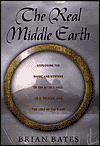
With the enormous popularity of Peter Jackson’s Academy Award-winning LOTR movies has come a flood of books and blogs of exegesis and explication of “what Tolkein really meant.” This isn’t one of them. This book is history, not literary criticism, but for any reader of Tolkein and for anyone interested in Norse or Germanic mythology, The Real Middle-Earth is a treasure trove as rich as the find at Sutton Hoo. As we know, Tolkein was a scholar of Old English and northern European cultures. Bates, who is a professor of psychology at the University of Brighton, England, and co-author of a book with John Cleese, sets out to discover the truth about the so-called Dark Ages.
Let’s define some terms and put what Bates calls “the real Middle-earth” into its proper context. Named from the Christian point of view, the Dark Ages are said to encompass the barbaric centuries in Europe from the fall of the Roman Empire (about 476 C.E.) to the beginning of the Middle Ages, which came to England with the Norman Conquest of 1066. (The age of Charlemagne, in western Germany, is said to be an early Renaissance. The Age of Cathedrals, 1200 to about 1400, is called the High Middle Ages. The Renaissance in Italy began about 1400 with the Medici rule in Florence, though it didn’t reach England until about 1500, the age of Henry VIII.) In the British Isles, the thousand year period of 1 to 1000 C.E. runs from late Celtic days, through the Roman invasion and departure, through the height of the power of the barbarian tribes, and through King Arthur’s time to the settlements of the Angles, Saxons, Jutes, and other Germanic tribes who gave England its character and the basis of its language. It ends with the Viking incursions and Norman invasion (William the Conqueror’s ancestors were Vikings).
Using literary sources including Beowulf, Tacitus and other Roman authors, Snorri Sturlusson and others who wrote about Scandinavian mythology, the works of the Fathers of the Church and Christian apologists and missionaries, and obscure books of medieval poetry, magic, and lore, plus modern works of genealogy, history, and archaeology, plus encylopedias and atlases, Bates sets out to explore what he calls the Real Middle-earth, the England of that thousand years. His bibliography is nearly overwhelming in its scholarship—and mighty useful to anyone who wants to know more about the people who worshipped Odin, Thor, Frigg, and Freya. Bates visits forests, burial sites, and holy wells. He talks about shamanism, wizards, dragons, elves, dwarves, ravens, shapeshifters, and seeresses. He explains how what Tolkein wrote is based on what the Anglo-Saxons and neighboring tribes believed about life, the universe, and reality, how they viewed the landscape around them and the sky above. He even relates “liminal moments” (November eve and May eve) to Bilbo’s adventures and to the Otherworld.
“The gods and goddesses lived in the bright spaces of the Upperworld, along with the light elves,” Bates writes. “The great cultures of those times, the Celts, Anglo-Saxons and Norse, infused their lives with a remarkable imagination and a sense of spirituality. The natural landscape of Europe took on a whole new meaning—a deeper, enchanted dimension, making it a realm of magic and mystery. These were the people of the Real Middle-earth” (p. 3). It was this real, historical Middle-earth, he continues, upon which Tolkein based his geography (we all know that the Shire is an English village), many of his characters (Gandalf and Saruman as shamans), and the ground of his story.
For modern pagans who want to explore the background of Wicca and European spirituality, this book is highly recommended. It shows that sometimes geography and spirituality and history are the same thing.
~review by Barbara Ardinger, Ph.D.
Author: Brian Bates
Palgrave Macmillan, 2002
